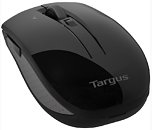Monday, September 19th 2011
Targus Rolls Out new WiFi-connected Wireless Laser Mouse
Peripherals specialist Targus, released the new AMW58US wireless laser mouse that uses WiFi to interface with the computer, and in the process, eliminates the need for a dongle. Its design is based on the OZMO2000 by Ozmo Devices. The mouse is 8.25 cm long, 5.71 cm wide, and is about 2.54 cm tall. It has a five button layout, with a 4-way scroll-wheel, and is ambidextrous in shape. Powered by 2 alkaline batteries, it can provide up to 12 months of usage. Backed by a 1 year warranty, the Targus AMW58US is priced at $49.99.
Source:
TechConnect Magazine



10 Comments on Targus Rolls Out new WiFi-connected Wireless Laser Mouse
Some people spend a small fortune to get all their bits and bobs to all work on mode "N" - so that they can actually USE the bandwidth.
If even ONE item runs below mode N then EVERYTHING runs below mode N - UNLESS you have a Multi-Band Router.
Now that may be well & good but almost NOBODY has a multi-band Wireless Network Device in their Laptop.
(My understanding being that the mouse pairs DIRECTLY with the Laptop/Computer - From other products)
If this mouse runs anything less than Mode N, then surely your computer itself will also have to step down to match the mouse - effectively trashing any point in mode N at all since no matter how well managed all your devices and routers are your actual computer still cannot talk at that speed.
Unless the moue IS mode N compliant...
...which just seems unlikely - that kind of bandwidth in a mouse just seems like the kind of effort a manufacturer wouldn't bother with - particularly if you are trying to focus on extra low power usage.
Its far more complicated than you've made it out to be.
See Muss, I've heard a LOT of people who, I assume, just like you, ALSO don't have one of these mice (HP has some WiFi mice too I think) say : "it's more complicated than that" and "It wont slow anything down" without ever actually testing that theory - even if it is an uninformed theory - A possibility I will completely accept, as I don't use a lot of wireless networking, and am not by any means an expert on it, hence I ask in the first place..
This IS a technical forum - Please be the first to explain it to us properly?
For example - I have a small G network - and had a printer that only ran mode B - Whenever the printer was in use EVERYTHING ran at mode B.
Printer stopped, things stepped back up.
So if the mouse is running all the time(and assuming it has to run a protocol below your desired one- we still have no confirmation on that), how will it NOT have to slow things down - you cant communicate on 2 protocols at once with a single controller?
Even a Multi Band router can't do that - it simply bridges multiple independent controllers, and if the mouse is paired directly to your PC, PC's don't typically have that technology - usually only a router, and if you PC controller has to speak the same language as the mouse, in order to speak to the mouse - how can it simultaneously speak a different language to the rest of the network? (Unless there IS a way to use 2 protocols at once - which I am unaware of in my limited understanding)
I say : Les get The W1zZzZzZz to get one of these mice, set up a nice fat Mode N file transfer over the network , then wiggle the mouse around and see what happens - Now that a mouse is using your data network - any review of the product should also reflect the devices load on that network - and to date I can find no reviewer who ever thought to look at that aspect - Even if only to prove to people like me that it makes no difference at all :)
Who do we send an email to requesting that they send him a review sample?
so having a G device on the network transmitting, will mean the N devices have less data bandwidth available to them - but only when its transmitting (and while a mouse is transmitting 'constantly' as far as a user is concerned, its not constant as far as data rates go.)
your old B/G example isnt how the tech works these days, that was a problem with B/G, and is not a problem with mixed G/N.
i run a mixed G/N network, and my speeds do not change when i power off the G devices. no B devices to test with.
so if you had several G devices on the network transmitting large amounts of data all the time, yes, your N speeds would slow down. however, slowed down does not mean locked to G speeds.
When the HP mouse came out they seemed to imply that the mouse connects DIRECTLY "AD-HOC" style to your PC's wireless controller - skipping the network & router.
If the mouse constantly transmits mode G for example, can the standard Wireless device of a Laptop / PC also interleave simultaneously G and N packets like the router can?
I was unaware that the embedded controller on the actual PC could do that on mode N - and thought it would have to step down to whatever the mouse is doing - and hence limit all of your access to the network VIA your controller, to be whatever the mouse does.
Again I have very little mode N experience - I live in a pretty backwards country :(
network adaptors on a PC can only connect to one network at a time, so if thats how this works - then you need a dedicated adaptor for the mouse.